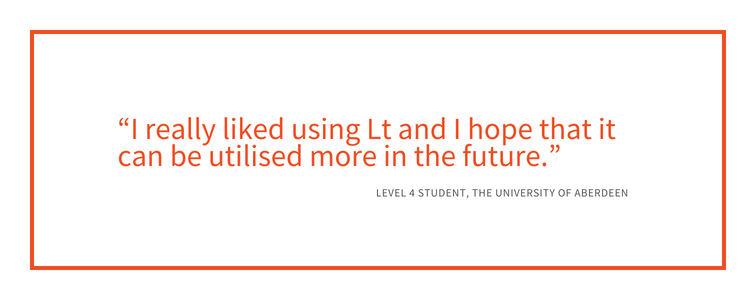“I decided I was going to change this essay because it was just boring. It was what everybody had done forever and ever and ever.”

Dr. Ann Rajnicek
Dr. Ann Rajnicek is a Senior Lecturer in the School of Medicine at the University of Aberdeen, Scotland.
Wanting to engage her fourth-year students and teach transferable skills, she set about transforming a traditional essay on developmental neuroscience into an interactive, online assessment. Her experiment was a success - positive student feedback rolled in and time spent on marking was significantly reduced.
Read on to discover how you can make traditional essays more engaging and save time on marking. In this interview, Dr. Rajnicek shares her teaching philosophy and practical tips for using technology to boost student satisfaction and interest.
Lighting the 'science spark'
Ann has always been interested in science, and her early experiences helping struggling students led to a life-long passion for education.
She says, "My first opportunity to help students learn was as an undergraduate volunteer in a drop-in center where students who needed a confidence boost in mathematics and statistics could come for a one-to-one session."
"It was so lovely to see people with a perceived block against calculations suddenly ‘get it'. The teaching spark was smoldering."
During her PhD on the role of electrical signaling in wound healing and nerve growth at Purdue University, Ann worked as a teaching assistant, delivering the hands-on lab components of multiple courses.
Balancing her PhD work and teaching responsibilities meant she had to absorb content fast: "Out of sheer necessity I learned lots of information very quickly, barely keeping one step ahead of the undergraduates I was teaching on two different lab topics each week."

Dr. Ann Rajnicek and her students using Lt to explore electroencephalography (EEG).
Her teaching strategy was to be one of the students: "My strategy was, let's work it out together - because we really were. It worked out well, and I've used that as I've gone through my teaching career, taking it step-by-step and putting yourself in the student's place."
Using Lt in a practical lab
Now a Senior Lecturer at the University of Aberdeen, Ann is research-active and also designs undergraduate courses, delivering labs, lectures, and lab research projects for undergraduate and postgraduate students.
At Level 3, Lt is used to deliver an off-the-shelf lab practical called Spinal Reflexes. Students use PowerLab with a tendon hammer to measure electrical activity in the muscle and test human reflexes.
Related: Discover our USB plug-and-play Tendon Hammer Sensor »
“The students really liked the hands-on aspects of the practical and that it was done in groups. It made them feel more relaxed about the sessions. They could also work at their own pace.”
“Another bonus was that most of it was marked automatically, speeding up feedback time.”
Transforming a traditional essay assessment
Ann also coordinates the Level 4 Developmental Neuroscience course, which serves around 80 diverse students working toward degrees in Neuroscience with Psychology, Physiology, Developmental Biology, Anatomy, and medical students. A key assessment in this course was an essay, which was beginning to feel boring.

“After a few years, I decided to move away from the essay. It felt old-fashioned and the students were writing essays in other courses, so they were already getting that skill elsewhere.”
“Plus, it was a real chore to chase up the marks from staff who were busy doing other things at that time of year. It could take months to get all of the marks back.”
Building a relevant case study: Zika virus
Ann was looking for a new assessment format that students could complete in their own time but that was also new, interactive, and interesting to her diverse student audience.
“I wanted it to improve their critical thinking and give them practice reading scientific literature at a high level. As a senior editor on a journal it occurred to me that it could be a good idea to get them to ‘peer review’ a paper as part of this assessment.”
Ann began to look through the lessons available in Lt, and soon found a case study on a man with Guillain-Barré syndrome. At the time, Zika virus was raging in South America, and was thought to be linked to microcephaly in fetuses. Ann chose a recent paper that aimed to develop a mouse model of zika-induced microcephaly in utero, and linked it to the case study via the fact that adult human Zika virus infection can lead to Guillain-Barré syndrome.

The case study in Lt on Guillain-Barré syndrome, featuring a real patient’s journey through presentation, diagnosis, and treatment.
Related: Discover the medical case studies available in Lt »
Instead of an essay structure, Dr. Rajnicek’s new assessment was a series of questions on the scientific content, research design, data, and presentation of the chosen scientific paper.
“I chose a paper that I felt had clear weaknesses. Then at the end I had the students write a letter to the editor stating the strengths and weaknesses of the paper and offering suggestions for improvement.”
Ann designed her course so that most questions could be marked automatically: “This meant that the marking was very quick. Instead of several months the feedback and marks could be delivered within a few days. The students really liked that the feedback was quick and useful.”
“With a Friday deadline I can get the marks back by Monday lunchtime.”
Dr. Rajnicek saved time, too, by creating model answers in Lt that were shown to every student. “I was able to make a model answer for them that showed exactly what I was looking for. So there was no need to write the same comments repetitively on the submissions, saving me time and assuring consistent feedback.”
Student feedback on the interactive assessment
Transforming the traditional essay format was a success from an administrative perspective, but what did the students think?
Ann gave an opinion poll to her students, who responded to questions on a scale from 1 (not at all) to 5 (extremely). She shares the responses below:
| Survey question | Student response |
|---|---|
| How useful was this type of assessment for learning new things? | 83% rated this 4 or 5 |
| How useful was this assessment in terms of critical thinking about a research paper? | 89% rated this 4 or 5 |
| Other feedback from students included: | |
| Compared to writing a course essay I found this assessment (in terms of learning new things). |
|
| 97% said “false” |
Producing competent students with a passion for science
One of the reasons Ann decided to create an interactive case study that asked students to critique a paper, rather than a traditional essay format, was that she wanted them to grasp the complexity of science in real-life.
”When they're working in the lab, they find out how difficult it is to actually produce the data [they see in those papers].”
With many students graduating from science degrees and working in totally different industries, it’s important that they develop transferable skills that will help them to succeed - as “not everyone finds science to be their ultimate calling”.
“The main goal is to train students for the ‘real world’ of what comes next after university, not just the scientific nuts and bolts. I want to make sure they leave my courses having acquired a range of skills that will serve them in scientific jobs, or being able to identify transferable skills from the courses they can apply elsewhere.”
Tips for using technology in your teaching
1. Take advantage of support resources
Lt has a shallow learning curve - as Ann says, “I learned sufficient basics to author a lesson in a weekend.”
“I would just say to get online and look it up; the help that I found was so straightforward and clear that I could just sit down and do it, and I was surprised how easy it was.”
- YouTube videos and online help are available: check out Getting Started with Lt - Quickly!
- Use Student Preview to test-drive your lessons once built.
Despite poor experiences with other online learning tools, Ann found it easy to author in Lt. “You just start a page, and you put your stuff on it, and you're done. I found authoring in it very, very easy, and that online help was incredible. It was so easy to use.”
2. Use technology to supplement in-person contact
Technology allows you to future-proof your course and to accommodate diverse student needs and timetables.
However, technology shouldn’t replace in-person contact entirely - rather, use it to supplement this face-to-face time in a creative way that adds value to the students’ learning experience.
Related: Check out this free, on-demand webinar about technology-enhanced education »
3. Use a cloud-based tool
Ann found the implementation process less stressful because she knew her work was saved. “I liked that it could revert to the most recent version if I made a mistake. I didn't feel that if I made a mistake I was going to lose everything, because it was out there in the cloud, and I could get back to it.”
In Lt, drafts are saved automatically, so you can revert to an earlier version. Don’t be afraid to jump in and make a mess!
4. Start from pre-existing resources
Ann was initially not convinced that Lt would be an easy way to transform her course. “I’ve used Moodle before, and it's just never as easy as that.” However, by using the pre-existing case study in Lt, and using the intuitive authoring tools, she found it to be surprisingly simple.
“Really, [I] put the whole assessment together in a weekend - and I was building it on the base of something else that already existed in Lt. It was a lot easier. I don't see how you could go wrong with it, so I've been telling everybody about it. It's great.”
5. Discuss with peers
Find someone in your faculty who is also interested in using technology for teaching and work through your ideas with them. To encourage colleague engagement, you can share the benefits Lt will bring to the course:
- Tailored content
- Rapid marking
- Quality feedback
- Interactive engagement
- Honing critical thinking
If you need some help to convince your Dean or Head of Department to adopt Lt, you can use this letter template.
Looking to the future
Lt is also used in Level 2 courses at the University of Aberdeen, where it "has improved the ability to give timely, detailed, and consistent feedback."
Ann continues to seek ways to engage her students with science. “I want to fan the spark of the flame of scientific interest where I can sense it. Part of our job as educators is to guide a student’s enthusiasm and to help them make the most of their inherent interests.”
“It’s a joy to see someone come up after a lecture to ask if they can volunteer to work in my research lab because of something I’ve taught them in lectures. To see that spark come alight is so rewarding.”
Are you curious about how you can use Lt in your teaching? Try Lt today »

Dr. Ann Rajnicek
Dr. Ann Rajnicek,
Senior Lecturer,
School of Medicine, Medical Sciences and Nutrition,
Institute of Medical Sciences, The University of Aberdeen.
Dr. Ann Rajnicek (BS, PhD, FRSB) graduated with a PhD from Purdue University and serves as a Senior Lecturer in the School of Medicine at the University of Aberdeen, a UK Top 20 and World Top 200 University.
Ann is also a Senior Personal Tutor of the School of Medicine, Medical Sciences and Nutrition, providing pastoral and academic support to undergraduate students, and she is a member of the Institute of Medical Sciences Equality, Diversity, and Inclusion Committee, which focuses on promoting diversity and wellbeing for students and faculty in medicine, biomedical sciences, and associated disciplines.





